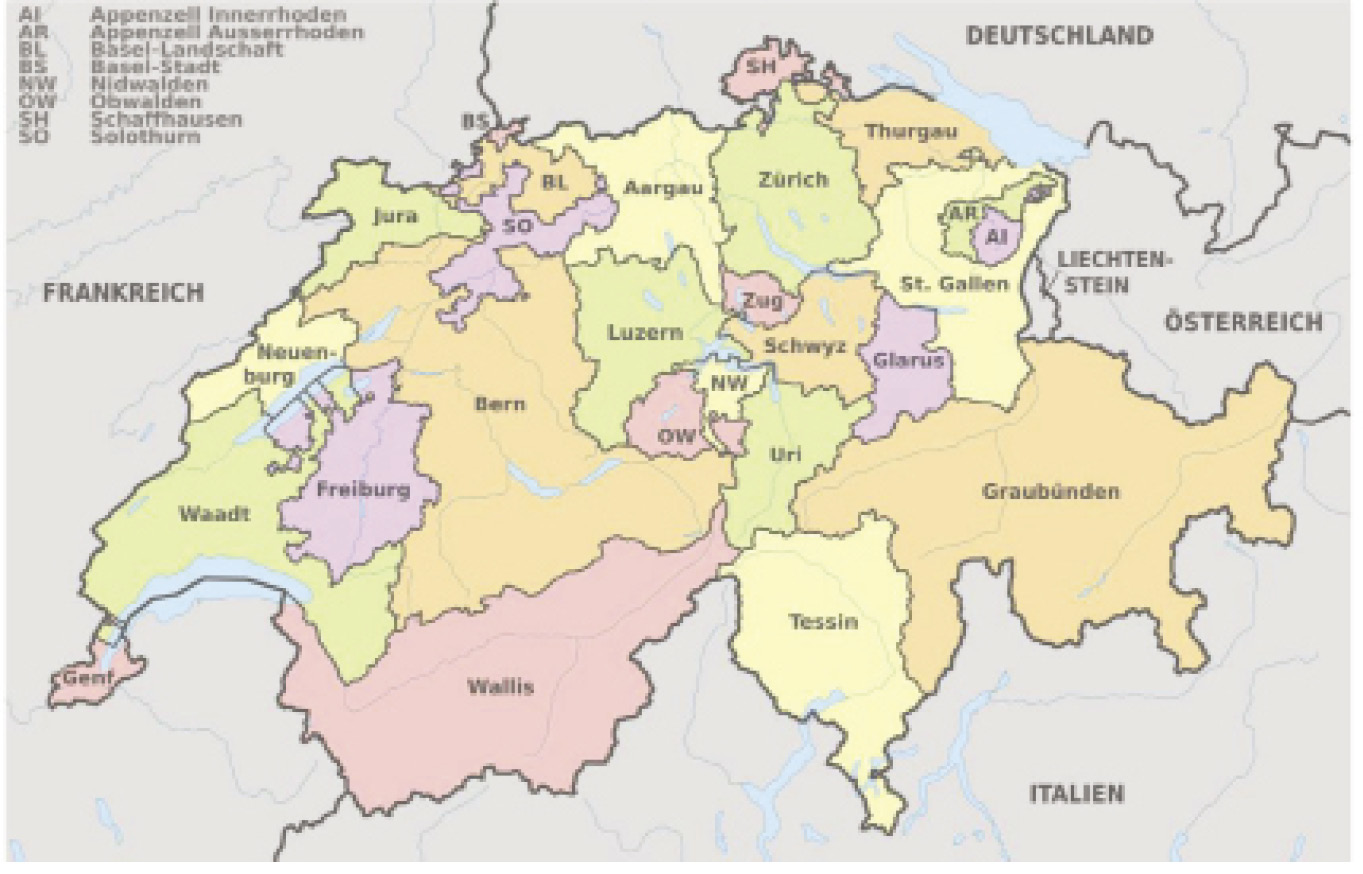20: Untitled Page 05
- Page ID
- 10334
In 1848, there were 25 cantons in the Swiss Confederation: Zurich, Bern, Lucerne, Uri, Schwyz, Obwalden and Nidwalden, Glarus, Zug, Fribourg, Solothurn, Basel Stadt and Basel Landschaft, Schaffhausen, Appenzell Ausserrhoden and Appenzell Innerrhoden, St. Gallen, Graubünden, Aargau, Thurgau, Ticino, Vaud, Valais, Neuchâtel, and Geneva.35 In 1978, Jura was accepted as the 26th canton in a constitutional referendum after it had decided to secede from the canton of Bern in a popular vote.

Figure 8: The 26 Cantons of Switzerland36
Up to this day, understanding the role of the cantons is key in being able to understand the Swiss federal system. The Constitution of 1848 established Switzerland as a confederation of 25 federal states (cantons) that – much inspired by the United States of America – only conferred some powers (like foreign relations or control over the military) to the central authorities and left all the others (like policing, schooling, taxes, health care, etc.) with the cantons. Thus, from the very beginning of the Swiss federal state’s existence, the cantons retained their autonomous standing.
This strong independent position of the cantons can best be understood by examining Article 3 of the Constitution, which has not changed since 1848: “The Cantons are sovereign ... They exercise all rights that are not vested in the Confederation.” The confederation, on the other hand, only possesses “the duties that are assigned to it by Federal Constitution” (Article 42 Constitution). The principles for the allocation of powers and tasks are circumscribed in Article 43a of the Constitution: “The Confederation only undertakes tasks that the Cantons are unable to perform or which require uniform regulation by the Confederation.” Traditionally, there were only a limited amount of tasks vested in the confederation. In recent years, however, the confederation has assumed greater responsibility. The feeling had begun to develop, particularly in the fields of civil procedural law (Article 122 I Constitution), criminal procedural law (Article 123 I Constitution), vocational and professional education and training (Article 63 Constitution), or road transport (Article 82 Constitution), that nationwide uniform legislation was required. Nevertheless, despite these developments, the cantons remain strong and independent entities within the federal system today.
Each canton must provide for a democratic system of government.37 Firstly, this means that the people of the canton must have the opportunity to elect their representatives to the cantonal parliament. Secondly, the separation of powers must be respected within the canton. Separation of powers is guaranteed in all 26 cantons. Each canton has a democratically elected cantonal parliament, an executive, and an independent judiciary. The cantonal parliaments issue the cantonal laws, for example on education or on regional planning. These cantonal laws are then implemented by the cantonal executives and controlled by the cantonal courts. So, for example, a cantonal government (executive) issues permits to build houses. If such a permit is refused or restricted, the individual who wants to build a house can take the government to court, and the court will decide upon the application of the law in the circumstances. Thirdly, the cantonal constitutions themselves must be democratically approved and the people of the canton must have the possibility to amend or change the constitution in a popular vote.38
35Article 1 Constitution of 1848.
36Source: Wikipedia (https://perma.cc/5D9M-W82N); originator: TUBS.
37Article 51 Constitution: “Each Canton shall adopt a democratic constitution.”
38Article 51 I Constitution: “Each Canton shall adopt a democratic constitution. This requires the approval of the People and must be capable of being revised if the majority of those eligible to vote so request.”

